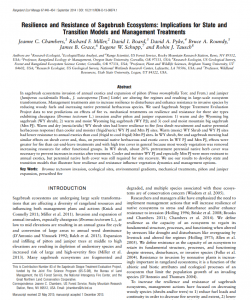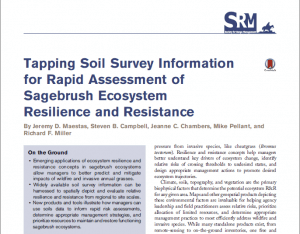Sagebrush
Access session recordings. Use password: SAGE2019
All Lands Summit was held at the Salt Lake City Downtown Radisson Hotel on Feb 5-7, 2019.
View guide.
This document was prepared to help scientists and the public, both of whom may not be familiar with bee taxonomy, learn how to practically identify bees in sagebrush steppe and shrubland habitats in southwest Idaho. We provide information to identify bees to the level of family and genus. A tentative list of the bee genera captured at sites used for insect community studies is included.
View article.
This study identified contrasting climate niches for ten Great Basin understorey forbs, including differences in both mean values and climate variability. These estimates can guide species selection for restoration by identifying species with a high tolerance for climate variability and large climatic niches. They can also help conservationists to understand which species may be least tolerant of climate variability, and potentially most vulnerable to climate change
View research brief.
Key findings of this research were:
- Burned low-elevation sagebrush sites can be seeded with mixes of native grasses, forbs and shrubs using rangeland drills adapted for seeding large and small seeds in separate rows.
- Seeding technique, timing of seed application, and seeding rate are important considerations when seeding Wyoming big sagebrush.
- The best techniques for establishing Wyoming big sagebrush are seeding at high rates via a drill in late fall.
- Success of seeding treatments on semiarid sites is ultimately dependent on weather conditions and competitive pressure from invasive weeds, and it may be best to delay treatments until conditions are predicted to be favorable, depending on the feasibility of weed control at the site.
Access database.
The spatially explicit, web-based Conservation Efforts Database is capable of (1) allowing multiple-users to enter data from different locations, (2) uploading and storing documents, (3) linking conservation actions to one or more threats (one-to-many relationships), (4) reporting functions that would allow summaries of the conservation actions at multiple scales (e.g., management zones, populations, or priority areas for conservation), and (5) accounting for actions at multiple scales from small easements to statewide planning efforts.
View article.
In this study, we used longer-term data to evaluate the relationships among soil climate conditions, perennial herbaceous cover, and cheatgrass cover following fuel management treatments across the environmental gradients that characterize sagebrush ecosystems in the Great Basin. Both prescribed fire and mechanical treatments increased soil water availability on woodland sites and perennial herbaceous cover on some woodland and sagebrush sites. Prescribed fire also slightly increased soil temperatures and especially increased cheatgrass cover compared to no treatment and mechanical treatments on most sites. Non-metric dimensional scaling ordination and decision tree partition analysis indicated that sites with warmer late springs and warmer and wetter falls had higher cover of cheatgrass. Sites with wetter winters and early springs (March-April) had higher cover of perennial herbs. Our findings suggest that site resistance to cheatgrass after fire and fuel control treatments decreases with a warmer and drier climate. This emphasizes the need for management actions to maintain and enhance perennial herb cover, such as implementing appropriate grazing management, and revegetating sites that have low abundance of perennial herbs in conjunction with fuel control treatments.
View article.
In sagebrush ecosystems invasion of annual exotics and expansion of pinyon and juniper are altering fire regimes and resulting in large-scale ecosystem transformations. Management treatments aim to increase resilience to disturbance and enhance resistance to invasive species by reducing woody fuels and increasing native perennial herbaceous species. This study used Sagebrush Steppe Treatment Evaluation Project data to test predictions on effects of fire vs. mechanical treatments on resilience and resistance for three site types. Warm (mesic) WY Shrub and WY PJ sites had lower resistance to annual exotics than cool (frigid to cool frigid) Mtn PJ sites. In WY shrub, fire and sagebrush mowing had similar effects on shrub cover and, thus, on perennial native herbaceous and exotic cover. In WY PJ and Mtn PJ, effects were greater for fire than cut-and-leave treatments and with high tree cover in general because most woody vegetation was removed increasing resources for other functional groups. In WY shrub, about 20% pretreatment perennial native herb cover was necessary to prevent increases in exotics after treatment. Cooler and moister WY PJ and especially Mtn PJ were more resistant to annual exotics, but perennial native herb cover was still required for site recovery. We use our results to develop state and transition models that illustrate how resilience and resistance influence vegetation dynamics and management options.
View article.
On the Ground Emerging applications of ecosystem resilience and resistance concepts in sagebrush ecosystems allow managers to better predict and mitigate impacts of wildfire and invasive annual grasses. Widely available soil survey information can be harnessed to spatially depict and evaluate relative resilience and resistance from regional to site scales. New products and tools illustrate how managers can use soils data to inform rapid risk assessments, determine appropriate management strategies, and prioritize resources to maintain and restore functioning sagebrush ecosystems.
View article.
This study developed range-wide population and habitat models for greater sage-grouse (Centrocercus urophasianus) that account for regional variation in habitat selection and relative densities of birds for use in conservation planning and risk assessments. The models demonstrate distinct clustering of relative abundance of sage-grouse populations across all management zones. On average approximately half of the breeding population is predicted to be within 10% of the occupied range. We also found 80% of sage-grouse populations were contained in 25 – 34% of the occupied range within each management zone. Range-wide population and habitat models account for regional variation in habitat selection and the relative densities of birds, thus they can serve as a consistent and common currency to assess how sage-grouse habitat and populations overlap with conservation actions or threats over the entire sage-grouse range.
Want to beef-up your library? You can request the following resources in hard copy from Génie (listed in order of most recent publication date). You can also add them to your electronic library, just follow the links for downloads.
Fire patterns in piñon and juniper land cover types in the Semiarid Western United States from 1984 through 2013, 2018. RMRS-GTR-372
Restoration handbook for sagebrush steppe ecosystems with emphasis on greater sage-grouse habitat—Part 3. Site level restoration decisions, 2018. USGS Circular 1426
Science framework for conservation and restoration of the sagebrush biome: Linking the Department of the Interior’s Integrated Rangeland Fire Management Strategy to long-term strategic conservation actions, 2017. RMRS-GTR-360
Pocket Guide to Sagebrush Birds, reprint, 2017. A partnership between Rocky Mountain Bird Observatory and PRBO Conservation Science
Pocket Guide to Sagebrush, reprint, 2017. Made possible by USU, NRCS, USFS, BLM, PRBO Conservation Science, NDOW, GBFSE
Ecohydrologic impacts of rangeland fire on runoff and erosion: A literature synthesis, 2016. RMRS-GTR-351
Using resilience and resistance concepts to manage threats to sagebrush ecosystems, Gunnison sage-grouse, and Greater sage-grouse in their eastern range: A strategic multi-scale approach, 2016. RMRS-GTR-356
A field guide for rapid assessment of post-wildfire recovery potential in sagebrush and pinon-juniper ecosystems in the Great Basin: Evaluating resilience to disturbance and resistance to invasive annual grasses and predicting vegetation response, 2015. RMRS-GTR-338
A review of fire effects on vegetation and soils in the Great Basin Region: Response and site characteristics, 2013. RMRS-GTR-308






